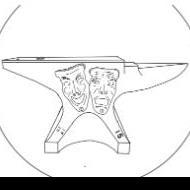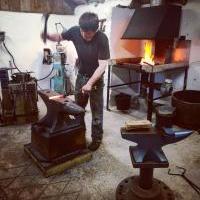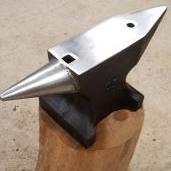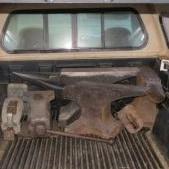
John Larson
Members-
Posts
1,716 -
Joined
-
Last visited
Contact Methods
-
Website URL
http://jolarson@comcast.net
Profile Information
-
Gender
Male
-
Location
Baltimore, MD
-
Interests
Metal working, wood working, old trucks, hot rods
Converted
-
Location
Baltimore, MD
-
Occupation
metal worker
Recent Profile Visitors
-
Iron Kiss 50 users?
John Larson replied to lawman's topic in Power Hammers, Treadle Hammers, Olivers
Thanks, JNewman. SJS should have been more explanatory. Troy, you won't have trouble with the Ironkiss 50's grunt. By the way, another customer rescheduled later, for September, which moves your build to early summer. :-) -
Air hammer choices
John Larson replied to will52100's topic in Power Hammers, Treadle Hammers, Olivers
It is imperative to NOT expose your utility air hammer cylinder and valves to synthetic oil in liquid or fume form because the synthetic oil causes the O-rings and seals to swell irreparably. Because air compressor manufacturers now seem to want to place synthetic oil in crankcases to increase times between oil changes, they have sabotaged valve and cylinder manufacturers who declare it imperative to not use synthetic oils. The NFPA published a technical paper in 1977 advising of the problem. Quincy reciprocating compressors seem to arrive with non-synthetic break-in oil, so when changing the oil after the break-in period just use standard non-synthetic oil. Every single encounter I have had with Ingersoll-Rand new compressors is that they use synthetic oil, but you need to verify the situation for yourself. If you obtain a new compressor or a used one that is almost new that uses synthetic oil you will have to clean out the crank case thoroughly, not just drain it, to eliminate all traces of synthetic oil. Fumes travel into the main air line and will definitely affect longevity of the valves in the utility hammer. A contaminated receiver tank will eventually cleanse itself, I suppose, but you may want to use a post-tank high efficiency oil fume filter to attempt to capture the fumes. Screw compressors are far worse than piston compressors in this regard. Tis a shame, but it is reality. Use old-fashioned mineral oil to avoid potential grief and expense. Apparently not all synthetic oils are damaging or damaging in equal; amounts. And not all valves are equally susceptible. Norgren valves are. I am doing research on Bosch-Rexroth (now Aventics) ceramic valves. As for air compressor sizing, Iron Kiss 50s can use a 3hp 2-stage compressor produce about 12 cfm at 100 psi. A 75 uses 5 hp, a 100 uses 7.5 hp. Quincy suggests 1 hp per 4 cfm at about 100 psi, but I think of a 5 hp pump producing 15 to 17 cfm at 150 psi. These suggestions for IK hammer sizes are for continuous running (multiple irons in the fire) A 60 gallon tank is best because it fills faster than an 80, and anything larger than 80 is too large for rapid tank recharging. -
Iron Kiss 50 users?
John Larson replied to lawman's topic in Power Hammers, Treadle Hammers, Olivers
SJS, you are a good advocate of power hammering. :-) -
Iron Kiss 50 users?
John Larson replied to lawman's topic in Power Hammers, Treadle Hammers, Olivers
Troy, I may as well say something for your benefit. You have the option to switch your order to a 75 if that is what you end up deciding may be your best choice. I sell 50s and 75s about equally in number. Whatever you decide on, just let me know. Any questions or comments can be sent to me via e-mail. -
Power Hammer vs Hydraulic Press
John Larson replied to Zachary's topic in Power Hammers, Treadle Hammers, Olivers
In addition to considering the maximum distance between hammer dies, it pays to know the inherent stroke length; most hammers short stroke. My air compressor driven utility hammers tends to have a 3 to 4 inch inherent stroke and a lever is used to position that range of reciprocating motion to account for tooling and stock thickness. So with my 11" maximum air space machines, a 4" inherent reciprocation at full throttle still allows for up to 7" of stock. For doing hammer heads I'd recommend a 125 to 150 pound hammer, large flat dies, and tooling that keeps the stock under control. If you use a press to shape the billet, you can get by with a lighter hammer for finishing work and probably eye punching. -
Power Hammer advice
John Larson replied to blackleafforge's topic in Power Hammers, Treadle Hammers, Olivers
John is a very good bloke who has provided me things freely. This is not a forum for airing resentments and anger; just doesn't work. -
Custom Dies Compatibility
John Larson replied to RyanMark's topic in Power Hammers, Treadle Hammers, Olivers
I can speak for Iron Kiss Hammers, LLC since I designed and manufacture them. The bottom die of the Chinese hammer is custom made to have the depression for the bowl shape. The piece can be fitted to an Iron Kiss bottom die. The top piece is also custom made and can be fitted to the top die. Here is how: The dies from Iron Kiss can be ordered with holes in them for attaching accessories. A bolt and two straps can be fitted to the forming piece and the straps welded. Very simple and effective. This approach is superior to use of spring fullers because the top and bottom pieces can be several inches apart when the hammer head is up. -
Making Little Giant Hammer Dies
John Larson replied to PaulKrzysz's topic in Power Hammers, Treadle Hammers, Olivers
The lengthwise "clench" angle is in the dies on Turkish hammers and Iron Kiss. Contact the formerly Sid Sudemeir company for accurate information on all things Little Giant. -
Hammer Recommendation
John Larson replied to RyanMark's topic in Power Hammers, Treadle Hammers, Olivers
I was not gauging my response as to the motor size. I do know that a 75 pound Iron Kiss utility hammer will out work a 75 pound Little Giant. I think it is also true for a Beaudry. Maybe not for a Fairbanks compact design; its reputation is top of the line. A reason why Little Giants and similar machines run on such low horsepower is that rebound of the hammer head aids the up stroke. Instead of a penetrating blow (squish) the Little Giants have more of a slapping blow. On utility hammers versus self-contained hammers, there is a consideration for the full tilt volumetric efficiency that needs to be made. Usually self-containeds have pretty good full throttle air flows and usually modern utility hammers seem a bit choked comparatively. But there are exceptions and good utility hammer designers work on this high end flow without sacrifice of control at all treadle depressions. Generalizations are difficult. Testing of as many hammers as possible makes enormous sense. What you enjoy working with depends as much on you and your requirements as it does on the hammer's specs. Why else are 25 pound Little Giants so useful to so many? -
Hammer Recommendation
John Larson replied to RyanMark's topic in Power Hammers, Treadle Hammers, Olivers
Patrick's response is superb. As for mechanicals hitting harder than air hammers, well, that is something I disagree with based on my years of observations. -
750lb Chambersberg
John Larson replied to monstermetal's topic in Power Hammers, Treadle Hammers, Olivers
A mighty big machine. I hope it is in good condition. And I hope your plan for moving to Idaho happens soon so that you can work in conjunction with your Dad. -
Anvil size vs hammer size, 2% or 10:1 or 15:1
John Larson replied to Glenn's topic in Blacksmithing, General Discussion
Interesting reading. My experience with my power hammers is that 20:1 makes a more fun hammer than with the previous 16:1. Way back in time I made I-beam spine hammers with a much lower ratio of about 8:1. I moved on to better hammer designs before I did any anvil changing, and the better hammer designs used centered guides for much better control and rebound/percussion effects. Thus,over time I have kept increasing anvil mass with improved "feel" and I rather expect that going higher would add the effect with some diminishing returns, My littlest 50 pound hammer has a 25:1 ratio, but I have never built that unit with less anvil mass and cannot really say anything about mass change effects. Most of the old tyme power hammers had too little anvil IMHO. The Massey Clearspace hammers from the UK were perhaps an exception. I have used many different anvils for hand forging over the years. My final purchase was a very large European anvil and I love its huge sweet spot (aka thick waist) and its massive top surface. Its mass allows me to hammer sideways on occasion and it tends not to budge, I seldom use hand hammers weighing more than 3 pounds. -
Air compressors in artic climate
John Larson replied to brian robertson's topic in Power Hammers, Treadle Hammers, Olivers
Brian. if your valve is designed to dump at start up, maybe you can trick it by shutting off and restarting. That way it would dump warm water from the day's activities. -
Treadle hammer pros and cons?
John Larson replied to welding teacher's topic in Power Hammers, Treadle Hammers, Olivers
If you would like to see an Iron Kiss power hammer being used for treadle hammer single blow work take a look on youtube at jcl10000. Just a thought provoker and not an advertisement. You can also look into the late Grant Sarver's Naked Anvil youtube videos where he shows a unique treadle hammer.





